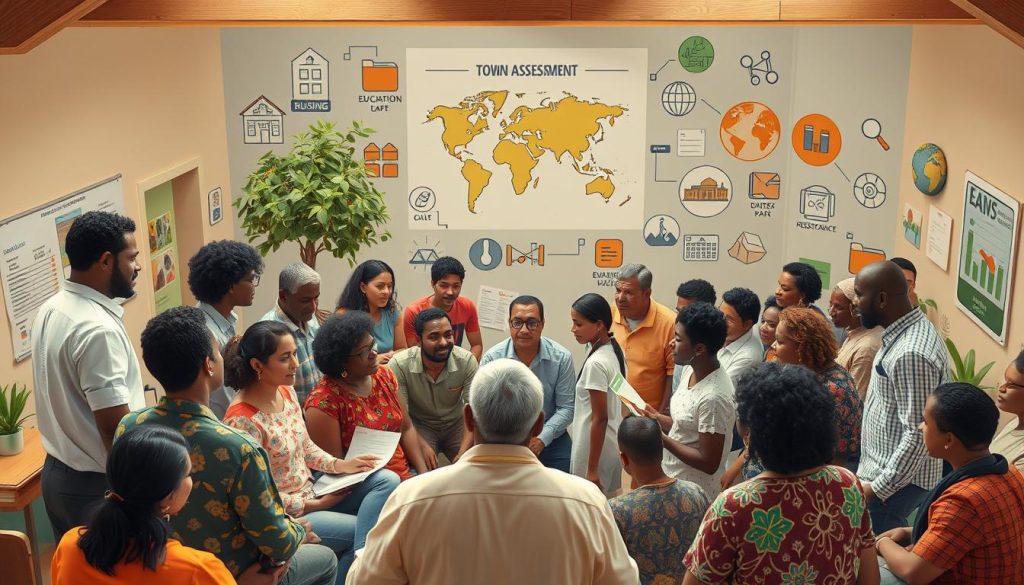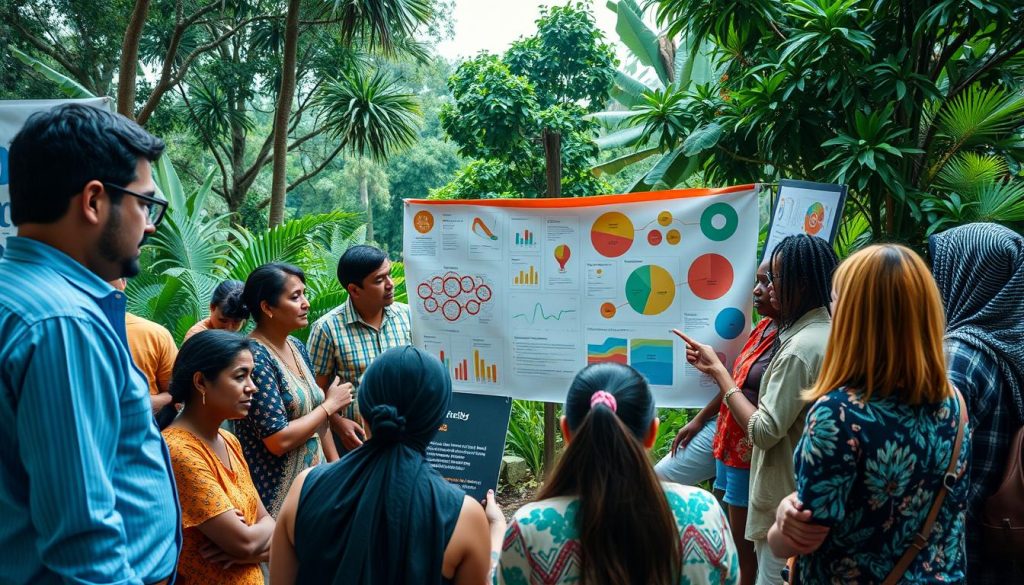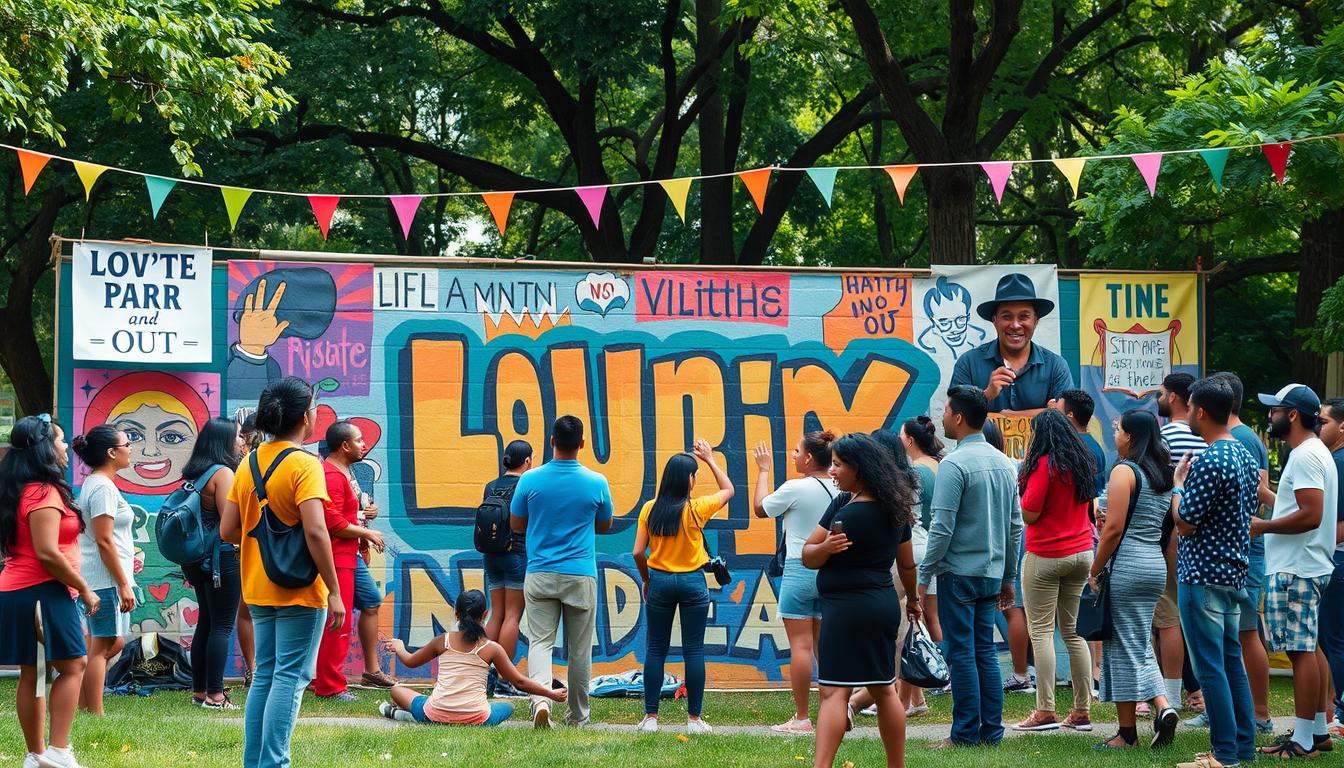I’ve seen how community advocacy can lead to real change. It’s about people coming together, speaking up, and making a difference. This powerful tool can change neighborhoods and have lasting social impact.
At the core of advocacy is community outreach. By connecting with others who share our concerns, we build a strong support network. Together, we can tackle tough issues like improving schools or fighting for cleaner air.
In this article, I’ll show you the basics of community advocacy. You’ll learn how to spot important issues, plan strategies, and get people on board. Let’s work together to bring positive changes to our communities.
Understanding the Power of Community and Advocacy
Community advocacy is key to civic engagement. I’ve seen how people coming together can lead to real change. Let’s dive into what makes advocacy powerful.
Defining Community Advocacy
Community advocacy means people working together on local issues. It’s about grassroots movements in action. When neighbors join, they make their voices louder and push for better changes.
The Importance of Collective Action
Collective action is at the heart of community advocacy. Working together makes us stronger. One person can make a difference, but a group can achieve more. This unity is crucial for successful activism.
Historical Examples of Successful Advocacy
History shows the power of community advocacy. The civil rights movement changed laws and attitudes in America. Environmental campaigns have saved forests and species. Women’s suffrage gave half the population the right to vote. These successes show that united communities can change society.
- Civil Rights Movement: Ended segregation and secured voting rights
- Environmental Advocacy: Protected landscapes and wildlife
- Women’s Suffrage: Achieved voting equality for women
Understanding these concepts shows why community advocacy is important. It’s not just about complaining; it’s about making real, lasting changes through civic engagement and grassroots activism.
Building a Foundation for Effective Advocacy
I believe effective advocacy starts with a strong foundation. To make a real difference in community development, we need to understand local issues, build relationships, and develop key skills.
First, I immerse myself in local concerns. I attend town halls, read local news, and talk to neighbors. This helps me grasp the true needs of my community.
Next, I focus on relationship building. I connect with local leaders, nonprofit organizations, and passionate volunteers. These partnerships are vital for creating lasting change.
To be an effective advocate, I continuously improve my skills:
- Public speaking
- Writing persuasive messages
- Understanding policy processes
- Organizing community events
I’ve found that volunteering with local nonprofits offers hands-on experience in these areas. It’s a great way to learn while making a difference.
| Skill | How to Develop | Impact on Advocacy |
|---|---|---|
| Public Speaking | Join local Toastmasters club | Confidently present ideas to groups |
| Writing | Write letters to local papers | Clearly communicate issues to wide audience |
| Policy Knowledge | Attend city council meetings | Understand how to influence decision-makers |
| Event Planning | Organize community clean-ups | Mobilize supporters for causes |
By focusing on these foundational elements, I’ve become a more effective advocate for positive change in my community.
Identifying Key Issues in Your Community

As someone who cares about community outreach, I understand the need to find important problems. Let’s look at how to find and fix the biggest issues in your area.
Conducting Community Needs Assessments
I start by collecting data through surveys, interviews, and local stats. This gives us a clear view of our community’s problems. I look at education, healthcare, and housing to see where we can do better.
Prioritizing Issues
Then, I sort issues by their impact and how easy they are to solve. I think about how many people are affected, how urgent it is, and what resources we have. This way, we focus on problems that will make the biggest difference.
| Issue | Impact | Feasibility | Priority |
|---|---|---|---|
| Youth Education | High | Medium | 1 |
| Affordable Housing | High | Low | 2 |
| Green Spaces | Medium | High | 3 |
Engaging Diverse Voices
Getting everyone involved is crucial for solving community problems. I make sure to listen to people from all walks of life. This means holding town halls, setting up diverse committees, and reaching out to everyone to hear their thoughts.
By doing this, I can find and tackle the most critical issues in my community. This sets the stage for real change and advocacy.
Developing a Strategic Advocacy Plan

Creating a strategic advocacy plan is key for success. A well-structured plan can turn Grassroots Movements into powerful forces for Community Development. Let’s explore the key steps to develop an effective strategy.
First, set clear goals. What do you want to achieve? Be specific and realistic. For example, “Increase local park funding by 20% within two years” is a measurable objective.
Next, identify your target audience. Who has the power to make the changes you seek? This could include local officials, community leaders, or even the general public.
Develop key messages that resonate with your audience. These should be concise, compelling, and aligned with your goals. Test these messages with a small group before wider distribution.
Now, outline specific actions and tactics. This is where your Advocacy Campaigns take shape. Consider a mix of approaches:
- Petitions and letter-writing campaigns
- Social media outreach
- Community events and rallies
- Meetings with decision-makers
Finally, create a timeline and assign responsibilities. This ensures your Grassroots Movements stay organized and focused on Community Development goals.
| Action | Timeline | Responsible Party |
|---|---|---|
| Launch online petition | Month 1 | Digital team |
| Meet with city council | Month 2 | Leadership committee |
| Host community rally | Month 3 | Event planning team |
Remember, flexibility is key. Be prepared to adjust your plan as circumstances change or new opportunities arise. With a solid strategy, your advocacy efforts can drive meaningful change in your community.
Leveraging Social Media for Advocacy Campaigns

Social media has changed how we do activism and reach out to communities. I’ve seen how it can make our voices heard and bring about change. Let’s explore how to use it for our advocacy campaigns.
Choosing the Right Platforms
Every social media site has its own strengths. Instagram and TikTok are perfect for sharing pictures and videos. Twitter is great for quick updates and chats. Facebook is ideal for planning events and building groups. LinkedIn is best for professional networking and reaching out to businesses.
Choose platforms that match your audience and message.
Creating Shareable Content
To make your content go viral, focus on these:
- Emotional appeal: Stories that touch our hearts are more likely to be shared
- Visual impact: Eye-catching images or infographics grab attention
- Relevance: Connect your message to current events or popular topics
- Call-to-action: Always tell your audience what to do next
Building an Online Community
An active online community can boost your advocacy. Start by posting valuable content regularly. Always reply to comments and messages quickly. Host live Q&A sessions or virtual events.
Create hashtags for your campaigns to track how they’re doing. Building a community takes time, so be patient and keep working at it.
Grassroots Mobilization Techniques
Grassroots mobilization is at the core of community and advocacy. It can change civic engagement and bring about lasting change. By using volunteering, we can create a movement that touches people everywhere.
Door-to-door canvassing is a great technique. It lets us connect with neighbors, share our message, and get support. People are more likely to join when they see our passion and hear our conviction.
Community events are also powerful. Organizing rallies, town halls, or info sessions brings people together. These events create unity and a place to share ideas and resources.
Building coalitions is key for stronger advocacy. Partnering with similar organizations amplifies our message and reaches more people. This teamwork often brings new solutions and bigger impact.
Here are some key strategies for effective grassroots mobilization:
- Develop a clear, compelling message
- Identify and train volunteer leaders
- Utilize social media to spread awareness
- Create easy ways for people to take action
- Celebrate small wins to maintain momentum
Successful grassroots mobilization empowers people to change their communities. By offering chances for meaningful civic engagement, we build a strong base for lasting advocacy and social progress.
Collaborating with Nonprofit Organizations
Working with nonprofits can really help our community grow. I’ve seen how these partnerships make a big difference. Let’s look at how we can work together well.
Finding Aligned Nonprofit Partners
To find the right partners, I start by researching local nonprofits. I look for groups that share my community’s goals. Online directories and community events are great places to connect. Once I find potential partners, I reach out to discuss how we can work together.
Maximizing Resources Through Partnerships
Teaming up with nonprofits lets us do more with less. We can share volunteers, office space, and expertise. This pooling of resources helps stretch budgets and increase our reach. For example, a food bank might partner with a job training program to address both hunger and unemployment.
Amplifying Impact Through Collective Efforts
When nonprofits join forces, our voices grow stronger. We can tackle bigger issues and reach more people. I’ve seen small groups achieve big wins by working together. From cleaning up parks to changing local laws, collective action makes a real difference.
By collaborating with nonprofit organizations, we create a powerful force for community development. Together, we can drive meaningful social impact and build stronger, more resilient communities.
The Role of Volunteering in Community Advocacy
Volunteering is key in community advocacy. I’ve seen how giving time and skills can make a big difference. When people come together, community outreach efforts really take off.
Volunteering can take many forms. You can organize events or attend town hall meetings. Every action helps. Volunteering not only benefits the community but also strengthens personal connections and builds leadership skills.
Here are some ways to get involved in community advocacy through volunteering:
- Join local nonprofit organizations
- Attend city council meetings
- Participate in neighborhood clean-up initiatives
- Mentor youth in community programs
- Help at local food banks or shelters
The impact of volunteering is huge. Volunteers are the backbone of many grassroots movements. Their passion and commitment can lead to big policy changes and better community services.
| Volunteering Activity | Impact on Community Advocacy |
|---|---|
| Phone banking | Increases voter turnout |
| Tutoring | Improves education outcomes |
| Environmental clean-ups | Raises awareness for conservation |
| Fundraising events | Supports local initiatives |
Every hour of volunteering helps make our communities better. By getting involved, we strengthen our neighborhoods and create lasting positive change.
Effective Communication Strategies for Advocates
In advocacy campaigns, how we share our message is crucial. Strong communication drives change. Let’s look at ways to improve our advocacy skills and inspire action in our communities.
Crafting compelling narratives
Stories have the power to move people. When I share a powerful story about our cause, it resonates. I use real-life examples to show how our activism changes lives.
This approach helps others connect with our goals on a personal level. It makes our community and advocacy efforts more relatable.
Tailoring messages to different audiences
Advocacy doesn’t work the same for everyone. I adjust my message based on who I’m speaking to. For younger people, I use social media trends.
When talking to policymakers, I focus on data and solutions. This tailored approach makes our campaigns more effective for diverse groups.
Mastering public speaking for advocacy
Public speaking can be intimidating, but it’s essential for advocates. I practice, use clear language, and stay passionate about our cause. Whether it’s a small meeting or a big rally, confident speaking spreads our message.
It helps rally support for our activism efforts. This confidence is key to making our voices heard.
